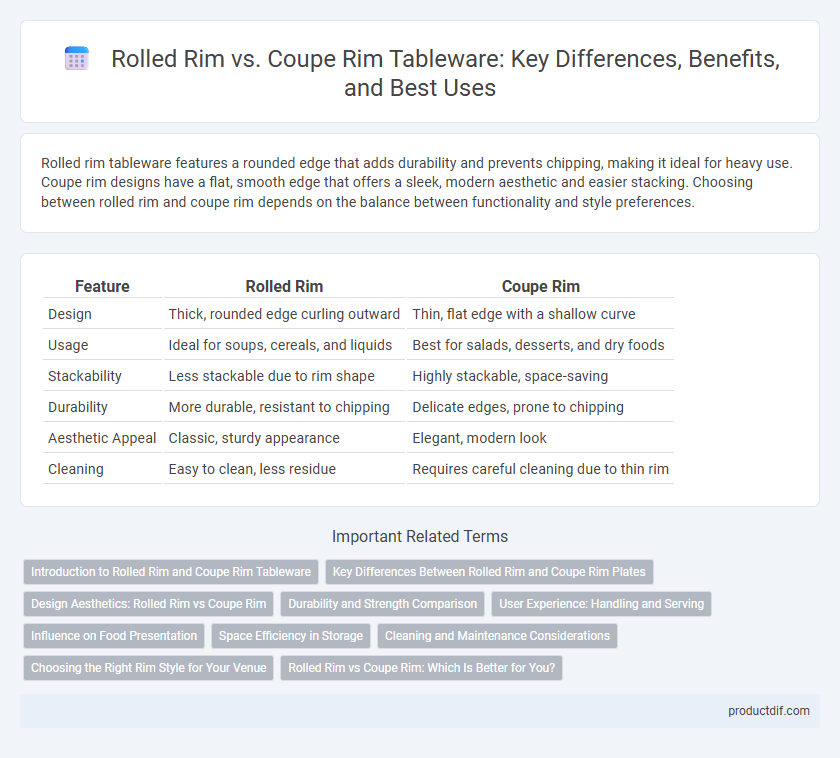Rolled rim tableware features a rounded edge that adds durability and prevents chipping, making it ideal for heavy use. Coupe rim designs have a flat, smooth edge that offers a sleek, modern aesthetic and easier stacking. Choosing between rolled rim and coupe rim depends on the balance between functionality and style preferences.
Table of Comparison
| Feature | Rolled Rim | Coupe Rim |
|---|---|---|
| Design | Thick, rounded edge curling outward | Thin, flat edge with a shallow curve |
| Usage | Ideal for soups, cereals, and liquids | Best for salads, desserts, and dry foods |
| Stackability | Less stackable due to rim shape | Highly stackable, space-saving |
| Durability | More durable, resistant to chipping | Delicate edges, prone to chipping |
| Aesthetic Appeal | Classic, sturdy appearance | Elegant, modern look |
| Cleaning | Easy to clean, less residue | Requires careful cleaning due to thin rim |
Introduction to Rolled Rim and Coupe Rim Tableware
Rolled rim tableware features a slightly curved edge that provides durability and prevents chipping, making it ideal for everyday use in busy kitchens. Coupe rim tableware showcases a smooth, rimless design with gently curved sides, offering a modern and elegant aesthetic preferred for fine dining settings. Both styles influence the presentation and functionality of plates, bowls, and serving dishes in restaurant and home environments.
Key Differences Between Rolled Rim and Coupe Rim Plates
Rolled rim plates feature a noticeable, slightly raised edge that provides a sturdy grip and prevents food from sliding off, making them ideal for casual dining settings. Coupe rim plates have a smooth, curved edge without a pronounced lip, offering a more modern and elegant appearance that enhances food presentation. The key differences lie in their edge design, functionality, and aesthetic appeal, with rolled rims emphasizing practicality and coupe rims focusing on sleek simplicity.
Design Aesthetics: Rolled Rim vs Coupe Rim
The rolled rim in tableware offers a classic, sturdy design with a distinct, raised edge that enhances durability and prevents spillage, appealing to traditional aesthetics. In contrast, the coupe rim features a smooth, unadorned edge that creates a sleek, modern profile, emphasizing minimalism and elegant simplicity. Both designs influence the visual and tactile experience, with rolled rims providing a tactile boundary and coupe rims promoting a seamless, open look.
Durability and Strength Comparison
Rolled rim tableware features a thicker, reinforced edge that enhances durability and resistance to chipping compared to the delicate, thinner edge of coupe rim designs. The structural strength of rolled rims makes them ideal for heavy use in commercial settings where frequent handling occurs. Coupe rims offer an elegant profile but are more prone to damage, making rolled rims the preferred choice for long-lasting, robust tableware.
User Experience: Handling and Serving
Rolled rim plates offer a secure grip with their slightly raised edges, enhancing user comfort during handling and reducing spillage when serving. Coupe rim plates feature a smooth, flat edge that provides a modern aesthetic and allows for easier stacking and plating of food, though they may be less stable when carrying multiple dishes. The choice between rolled rim and coupe rim impacts the ease of handling and the overall serving experience, especially in busy dining environments.
Influence on Food Presentation
Rolled rim plates enhance food presentation by providing a defined edge that contains sauces and garnishes, creating a structured and elegant plating appearance. Coupe rim plates offer a smooth, rimless surface that allows chefs to focus on artistic plating with minimal visual distraction, emphasizing the dish's colors and textures. The choice between rolled rim and coupe rim influences both the visual framing of the food and the overall dining experience, impacting the plate's functionality in gourmet presentations.
Space Efficiency in Storage
Rolled rim tableware features a raised edge that stacks securely, maximizing vertical space in storage and reducing the risk of slipping. Coupe rim plates, with their smooth, curved edges, tend to nest closely but may require more careful stacking to avoid chipping. Choosing rolled rim designs often enhances space efficiency in cabinets and complements organized kitchen environments.
Cleaning and Maintenance Considerations
Rolled rim tableware features a thicker, rounded edge that resists chipping and is easier to clean due to reduced food buildup in crevices. Coupe rim designs have a sleek, flared edge but may trap residue along the rim, requiring more thorough scrubbing during washing. Choosing rolled rims can lower maintenance efforts and prolong the durability of dishware in commercial or home settings.
Choosing the Right Rim Style for Your Venue
Rolled rim tableware offers a sturdy edge ideal for casual dining venues, enhancing durability and ease of handling, while coupe rim designs provide a sleek, modern aesthetic suitable for upscale restaurants seeking elegance. Venue style, service type, and customer experience should guide the selection, as rolled rims support robustness for high-traffic environments, whereas coupe rims create a refined presentation that elevates plated dishes. Prioritizing the rim style that aligns with your venue's ambiance and operational needs ensures both functional performance and visual appeal.
Rolled Rim vs Coupe Rim: Which Is Better for You?
Rolled rim tableware features a raised, thicker edge that enhances durability and prevents spills, making it ideal for casual dining and heavy use. Coupe rim plates, characterized by a smooth, slightly curved edge, offer a sleek, modern aesthetic suited for formal settings and presentation-focused meals. Choosing between rolled rim and coupe rim depends on whether you prioritize practicality and sturdiness or elegance and visual appeal in your tableware selection.
Rolled Rim vs Coupe Rim Infographic

 productdif.com
productdif.com